Xinghui Li
Phantom-Data : Towards a General Subject-Consistent Video Generation Dataset
Jun 23, 2025Abstract:Subject-to-video generation has witnessed substantial progress in recent years. However, existing models still face significant challenges in faithfully following textual instructions. This limitation, commonly known as the copy-paste problem, arises from the widely used in-pair training paradigm. This approach inherently entangles subject identity with background and contextual attributes by sampling reference images from the same scene as the target video. To address this issue, we introduce \textbf{Phantom-Data, the first general-purpose cross-pair subject-to-video consistency dataset}, containing approximately one million identity-consistent pairs across diverse categories. Our dataset is constructed via a three-stage pipeline: (1) a general and input-aligned subject detection module, (2) large-scale cross-context subject retrieval from more than 53 million videos and 3 billion images, and (3) prior-guided identity verification to ensure visual consistency under contextual variation. Comprehensive experiments show that training with Phantom-Data significantly improves prompt alignment and visual quality while preserving identity consistency on par with in-pair baselines.
Seeing in the Dark: Benchmarking Egocentric 3D Vision with the Oxford Day-and-Night Dataset
Jun 04, 2025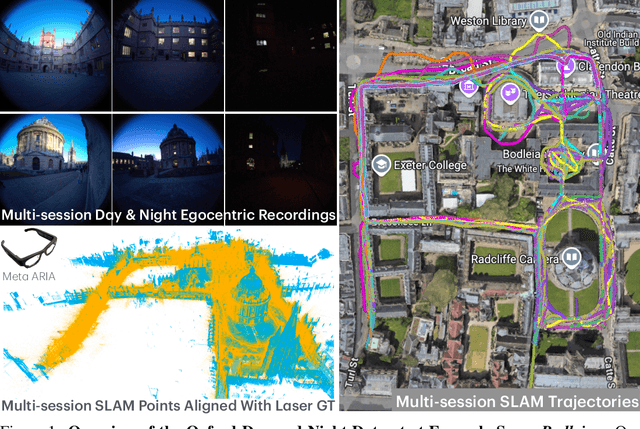
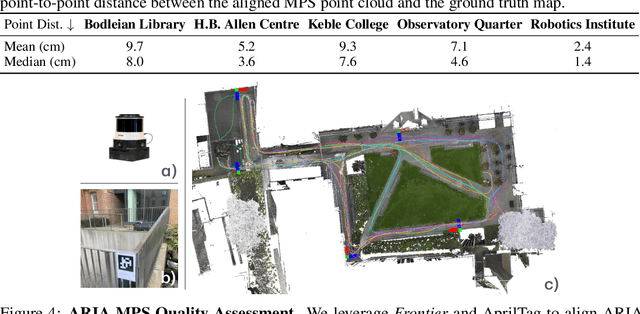

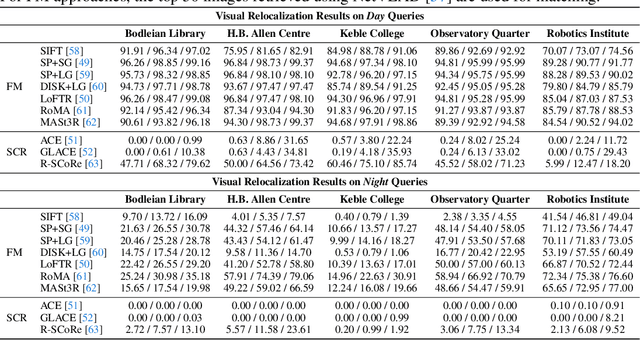
Abstract:We introduce Oxford Day-and-Night, a large-scale, egocentric dataset for novel view synthesis (NVS) and visual relocalisation under challenging lighting conditions. Existing datasets often lack crucial combinations of features such as ground-truth 3D geometry, wide-ranging lighting variation, and full 6DoF motion. Oxford Day-and-Night addresses these gaps by leveraging Meta ARIA glasses to capture egocentric video and applying multi-session SLAM to estimate camera poses, reconstruct 3D point clouds, and align sequences captured under varying lighting conditions, including both day and night. The dataset spans over 30 $\mathrm{km}$ of recorded trajectories and covers an area of 40,000 $\mathrm{m}^2$, offering a rich foundation for egocentric 3D vision research. It supports two core benchmarks, NVS and relocalisation, providing a unique platform for evaluating models in realistic and diverse environments.
Semantic Correspondence: Unified Benchmarking and a Strong Baseline
May 26, 2025Abstract:Establishing semantic correspondence is a challenging task in computer vision, aiming to match keypoints with the same semantic information across different images. Benefiting from the rapid development of deep learning, remarkable progress has been made over the past decade. However, a comprehensive review and analysis of this task remains absent. In this paper, we present the first extensive survey of semantic correspondence methods. We first propose a taxonomy to classify existing methods based on the type of their method designs. These methods are then categorized accordingly, and we provide a detailed analysis of each approach. Furthermore, we aggregate and summarize the results of methods in literature across various benchmarks into a unified comparative table, with detailed configurations to highlight performance variations. Additionally, to provide a detailed understanding on existing methods for semantic matching, we thoroughly conduct controlled experiments to analyse the effectiveness of the components of different methods. Finally, we propose a simple yet effective baseline that achieves state-of-the-art performance on multiple benchmarks, providing a solid foundation for future research in this field. We hope this survey serves as a comprehensive reference and consolidated baseline for future development. Code is publicly available at: https://github.com/Visual-AI/Semantic-Correspondence.
ViP$^2$-CLIP: Visual-Perception Prompting with Unified Alignment for Zero-Shot Anomaly Detection
May 23, 2025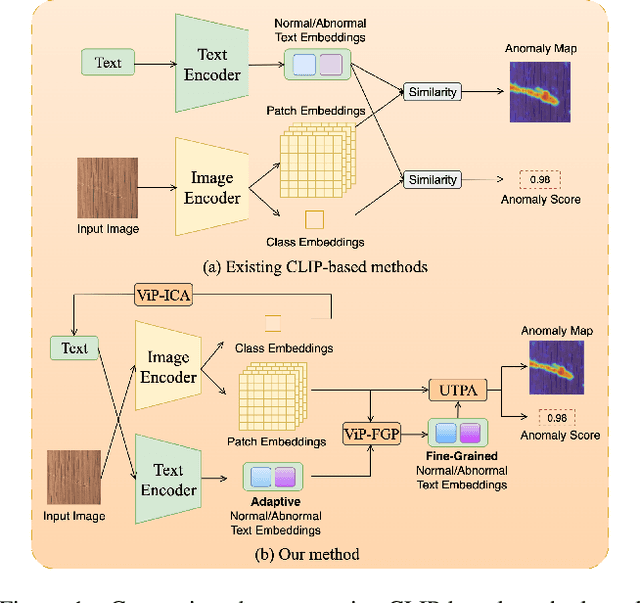

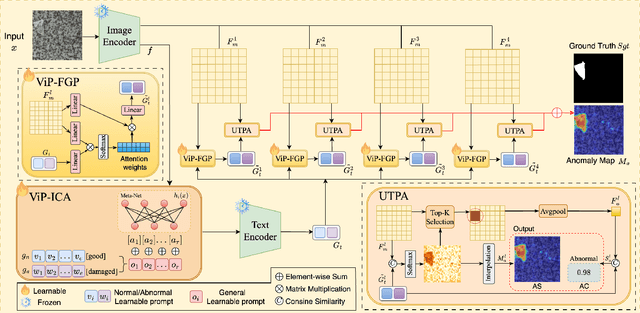

Abstract:Zero-shot anomaly detection (ZSAD) aims to detect anomalies without any target domain training samples, relying solely on external auxiliary data. Existing CLIP-based methods attempt to activate the model's ZSAD potential via handcrafted or static learnable prompts. The former incur high engineering costs and limited semantic coverage, whereas the latter apply identical descriptions across diverse anomaly types, thus fail to adapt to complex variations. Furthermore, since CLIP is originally pretrained on large-scale classification tasks, its anomaly segmentation quality is highly sensitive to the exact wording of class names, severely constraining prompting strategies that depend on class labels. To address these challenges, we introduce ViP$^{2}$-CLIP. The key insight of ViP$^{2}$-CLIP is a Visual-Perception Prompting (ViP-Prompt) mechanism, which fuses global and multi-scale local visual context to adaptively generate fine-grained textual prompts, eliminating manual templates and class-name priors. This design enables our model to focus on precise abnormal regions, making it particularly valuable when category labels are ambiguous or privacy-constrained. Extensive experiments on 15 industrial and medical benchmarks demonstrate that ViP$^{2}$-CLIP achieves state-of-the-art performance and robust cross-domain generalization.
DreamO: A Unified Framework for Image Customization
Apr 23, 2025Abstract:Recently, extensive research on image customization (e.g., identity, subject, style, background, etc.) demonstrates strong customization capabilities in large-scale generative models. However, most approaches are designed for specific tasks, restricting their generalizability to combine different types of condition. Developing a unified framework for image customization remains an open challenge. In this paper, we present DreamO, an image customization framework designed to support a wide range of tasks while facilitating seamless integration of multiple conditions. Specifically, DreamO utilizes a diffusion transformer (DiT) framework to uniformly process input of different types. During training, we construct a large-scale training dataset that includes various customization tasks, and we introduce a feature routing constraint to facilitate the precise querying of relevant information from reference images. Additionally, we design a placeholder strategy that associates specific placeholders with conditions at particular positions, enabling control over the placement of conditions in the generated results. Moreover, we employ a progressive training strategy consisting of three stages: an initial stage focused on simple tasks with limited data to establish baseline consistency, a full-scale training stage to comprehensively enhance the customization capabilities, and a final quality alignment stage to correct quality biases introduced by low-quality data. Extensive experiments demonstrate that the proposed DreamO can effectively perform various image customization tasks with high quality and flexibly integrate different types of control conditions.
DreamID: High-Fidelity and Fast diffusion-based Face Swapping via Triplet ID Group Learning
Apr 20, 2025Abstract:In this paper, we introduce DreamID, a diffusion-based face swapping model that achieves high levels of ID similarity, attribute preservation, image fidelity, and fast inference speed. Unlike the typical face swapping training process, which often relies on implicit supervision and struggles to achieve satisfactory results. DreamID establishes explicit supervision for face swapping by constructing Triplet ID Group data, significantly enhancing identity similarity and attribute preservation. The iterative nature of diffusion models poses challenges for utilizing efficient image-space loss functions, as performing time-consuming multi-step sampling to obtain the generated image during training is impractical. To address this issue, we leverage the accelerated diffusion model SD Turbo, reducing the inference steps to a single iteration, enabling efficient pixel-level end-to-end training with explicit Triplet ID Group supervision. Additionally, we propose an improved diffusion-based model architecture comprising SwapNet, FaceNet, and ID Adapter. This robust architecture fully unlocks the power of the Triplet ID Group explicit supervision. Finally, to further extend our method, we explicitly modify the Triplet ID Group data during training to fine-tune and preserve specific attributes, such as glasses and face shape. Extensive experiments demonstrate that DreamID outperforms state-of-the-art methods in terms of identity similarity, pose and expression preservation, and image fidelity. Overall, DreamID achieves high-quality face swapping results at 512*512 resolution in just 0.6 seconds and performs exceptionally well in challenging scenarios such as complex lighting, large angles, and occlusions.
Research on visual simultaneous localization and mapping technology based on near infrared light
Mar 04, 2025Abstract:In view of the problems that visual simultaneous localization and mapping (VSLAM) are susceptible to environmental light interference and luminosity inconsistency, the visual simultaneous localization and mapping technology based on near infrared perception (NIR-VSLAM) is proposed. In order to avoid ambient light interference, the near infrared light is innovatively selected as the light source. The luminosity parameter estimation of error energy function, halo factor and exposure time and the light source irradiance correction method are proposed in this paper, which greatly improves the positioning accuracy of Direct Sparse Odometry (DSO). The feasibility of the proposed method in four large scenes is verified, which provides the reference for visual positioning in automatic driving and mobile robot.
AnyDressing: Customizable Multi-Garment Virtual Dressing via Latent Diffusion Models
Dec 05, 2024



Abstract:Recent advances in garment-centric image generation from text and image prompts based on diffusion models are impressive. However, existing methods lack support for various combinations of attire, and struggle to preserve the garment details while maintaining faithfulness to the text prompts, limiting their performance across diverse scenarios. In this paper, we focus on a new task, i.e., Multi-Garment Virtual Dressing, and we propose a novel AnyDressing method for customizing characters conditioned on any combination of garments and any personalized text prompts. AnyDressing comprises two primary networks named GarmentsNet and DressingNet, which are respectively dedicated to extracting detailed clothing features and generating customized images. Specifically, we propose an efficient and scalable module called Garment-Specific Feature Extractor in GarmentsNet to individually encode garment textures in parallel. This design prevents garment confusion while ensuring network efficiency. Meanwhile, we design an adaptive Dressing-Attention mechanism and a novel Instance-Level Garment Localization Learning strategy in DressingNet to accurately inject multi-garment features into their corresponding regions. This approach efficiently integrates multi-garment texture cues into generated images and further enhances text-image consistency. Additionally, we introduce a Garment-Enhanced Texture Learning strategy to improve the fine-grained texture details of garments. Thanks to our well-craft design, AnyDressing can serve as a plug-in module to easily integrate with any community control extensions for diffusion models, improving the diversity and controllability of synthesized images. Extensive experiments show that AnyDressing achieves state-of-the-art results.
2DGS-Room: Seed-Guided 2D Gaussian Splatting with Geometric Constrains for High-Fidelity Indoor Scene Reconstruction
Dec 04, 2024



Abstract:The reconstruction of indoor scenes remains challenging due to the inherent complexity of spatial structures and the prevalence of textureless regions. Recent advancements in 3D Gaussian Splatting have improved novel view synthesis with accelerated processing but have yet to deliver comparable performance in surface reconstruction. In this paper, we introduce 2DGS-Room, a novel method leveraging 2D Gaussian Splatting for high-fidelity indoor scene reconstruction. Specifically, we employ a seed-guided mechanism to control the distribution of 2D Gaussians, with the density of seed points dynamically optimized through adaptive growth and pruning mechanisms. To further improve geometric accuracy, we incorporate monocular depth and normal priors to provide constraints for details and textureless regions respectively. Additionally, multi-view consistency constraints are employed to mitigate artifacts and further enhance reconstruction quality. Extensive experiments on ScanNet and ScanNet++ datasets demonstrate that our method achieves state-of-the-art performance in indoor scene reconstruction.
Fine-detailed Neural Indoor Scene Reconstruction using multi-level importance sampling and multi-view consistency
Oct 10, 2024



Abstract:Recently, neural implicit 3D reconstruction in indoor scenarios has become popular due to its simplicity and impressive performance. Previous works could produce complete results leveraging monocular priors of normal or depth. However, they may suffer from over-smoothed reconstructions and long-time optimization due to unbiased sampling and inaccurate monocular priors. In this paper, we propose a novel neural implicit surface reconstruction method, named FD-NeuS, to learn fine-detailed 3D models using multi-level importance sampling strategy and multi-view consistency methodology. Specifically, we leverage segmentation priors to guide region-based ray sampling, and use piecewise exponential functions as weights to pilot 3D points sampling along the rays, ensuring more attention on important regions. In addition, we introduce multi-view feature consistency and multi-view normal consistency as supervision and uncertainty respectively, which further improve the reconstruction of details. Extensive quantitative and qualitative results show that FD-NeuS outperforms existing methods in various scenes.
 Add to Chrome
Add to Chrome Add to Firefox
Add to Firefox Add to Edge
Add to Edge